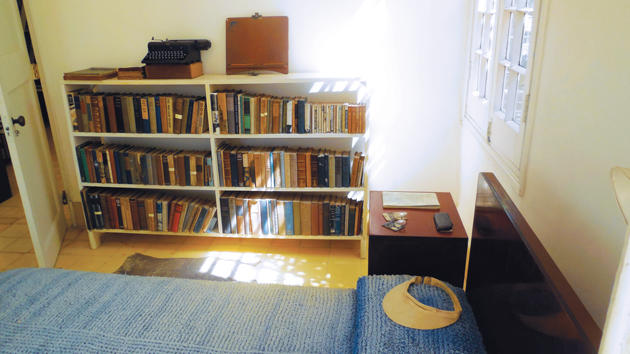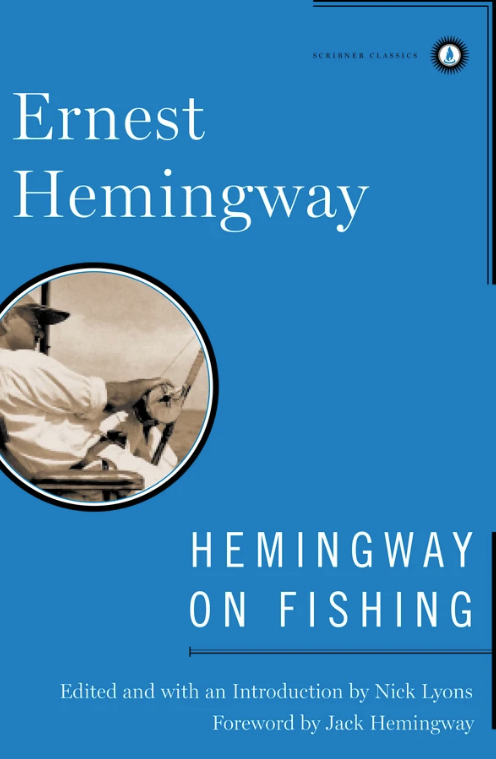The big moment came when I discovered just within the bedroom window, on the front left-hand side of the house, the desk on which Hemingway created such literary masterpieces as For Whom the Bell Tolls and The Old Man and the Sea.
The day after landing at the Jose Marti airport in Havana, I was walking through the parking lot of Finca Vigia, the Cuban home of Ernest Hemingway from 1939 to 1960. For any writer, such an occasion is the equivalent of scaling Mt. Parnassus, for here was the shrine of the ultimate word-crafter and surely there must be a spare muse or two lying about.
Located less than ten minutes from downtown Havana, Hemingway’s former home sits atop a hill in a tree-shaded glade rank with tropical vegetation and a distant view of the city and the coast. With the idea in mind that imitation is the sincerest form of flattery, I made this pilgrimage sporting a full Hemingway beard and wearing a cool, starched white, guayabera shirt. So complete was my camouflage that several European tourists politely asked if I would permit being included in their selfies.
The interior of the century-old house was closed to foot traffic and I was only permitted to peer through open doors and windows. All the daily paraphernalia of Hemingway’s life was there, open for scrutiny.

The big moment came when I discovered just within the bedroom window, on the front left-hand side of the house, the desk on which Hemingway created such literary masterpieces as For Whom the Bell Tolls and The Old Man and the Sea, the 1952 book that won him the Nobel Prize for Literature.
The scene at Finca Vigia has often been minutely described by other travelers and I suppose my own experience was something of a deja vu moment, however no less exciting, for right there lay the little kudu skin rug between the bed and a bookcase where he once stood, barefooted, in skivvies, alternately writing copy in longhand and then typing it.
On the chest-high bookcase, against the wall of the sunlit room, was Papa’s Royal Quiet Deluxe typewriter standing altar-like on top of an old book. From that instrument, now silent as Papa’s grave, once sprang such passages as, “You did not kill the fish only to keep alive and to sell for food, he thought. You kill him for pride and because you are a fisherman. You loved him when he was alive and you loved him after.” or “Dying was nothing and he had no picture of it or fear of it in his mind. But living was a field of grain blowing in the wind on the side of a hill. Living was a hawk in the sky…”
Ah, this man was a writer, Mr. tough-guy: drinking, bullying, brawling and womanizing on one hand and on the other, raising cats, pursuing the contemplative sport of fishing and sculpting sentences into towering edifices. I stood for a moment taking all this in while receiving the unyielding stares of a Cape buffalo mount high on the bedroom wall.
For the longest time there was great concern over the condition of the house and the collection of artifacts and papers, but in 2007 the Cuban government completed a major renovation of the property. The house, inside and out, looked great, but the status of the trove of Hemingway’s literary and personal papers stored there remains far from settled.
Circumnavigating the house, I carefully studied the contents of each room but kept returning to the corner bedroom and the typewriter. Crowded out by other visitors, I headed down a pathway to find Pilar, Hemingway’s 1934 Wheeler Playmate, a masterpiece of mahogany, teak, oak, brass and bronze. Completely restored in 1983 after extensive hurricane damage, the black-painted hull of the wooden sports fisherman now rests on a concrete cradle under a corrugated tin canopy. While the repairs were underway, Mystic Seaport’s restoration specialist, Dana Hewson, traveled to Cuba several times to offer suggestions and advice.

The full elegance and simplicity of her lines are open for an unobstructed view of her starboard side. Climbing the steps to the elevated, marina-like walkway encompassing the stern, the port side and bow, I saw up close her name lettered across the stern; the green painted cockpit, the wooden box frame outrigger; the steel roller-mount across the transom, which simplified the task of bringing big fish aboard; the helm once handled by Hemingway; and ladder-back Rybovitch fighting chair, the seat of many piscatorial battles.
But there were other Hemingway sites to explore, the first being Room 511 in the Ambos Mundos Hotel back in Havana where Hemingway stayed from 1932 to 1939 when he was not in Key West or Bimini. Like Finca Vigia, it’s preserved as a frozen-in-time memorial to Cuba’s favorite American, complete with the obligatory typewriter prop. I found it far less inspiring than his home and its typewriter, and I forgot to inquire if the hotel room mattress was the same as used by Hemingway. In light of his reputation. At least the bed was crisply made.
The guide there said Hemingway had written Death in the Afternoon and Green Hills of Africa in the room. For no particular reason I was reminded of one of his somewhat pithy remarks on the writing trade: “There is nothing to writing. All you do is sit down at a typewriter and bleed.”
Some blocks up Calle ObispoŠ Street from the hotel was one of Hemingway’s favorite watering holes, The Floridita Bar, his source of an unending flow of daiquiris. At what was his usual spot at the end of the bar stands a life-size bronze statue of him leaning against the bar and surrounded with framed photographs of him with Fidel Castro. My close attendance at this scene while wearing a guayabera shirt and beard once again provoked an unusual number of selfie requests. Gosh, just call me Papa.
I was thinking this place must have been a lot less crowded back in his day. Giving a parting salute to the perpetually jovial likeness of Hemingway, I went on my way to seek less-expensive refreshments and some elbow room.
Cuba is certainly not the same place as during Hemingway’s era. The colorful, carefree lifestyle of that time is over. The downtown buildings, though mostly brown and gray, are still stately, their somewhat stilted ambiance nonetheless exotic. However, the city is worth seeing, knowing the great storyteller walked these streets and lived in these buildings and once drank in the bright sunlight and Caribbean sea breezes along with the rum daiquiris and mojitos. Who knows, one of these days maybe some of that might rub off on me.
 Hemingway on Fishing is an encompassing, diverse, and fascinating assemblage. From the early Nick Adams stories and the memorable chapters on fishing the Irati River in The Sun Also Rises to such late novels as Islands in the Stream, this collection traces the evolution of a great writer’s passion, the range of his interests, and the sure use he made of fishing, transforming it into the stuff of great literature.
Hemingway on Fishing is an encompassing, diverse, and fascinating assemblage. From the early Nick Adams stories and the memorable chapters on fishing the Irati River in The Sun Also Rises to such late novels as Islands in the Stream, this collection traces the evolution of a great writer’s passion, the range of his interests, and the sure use he made of fishing, transforming it into the stuff of great literature.
From childhood on, Ernest Hemingway was a passionate fisherman. He fished the lakes and creeks near the family’s summer home at Walloon Lake, Michigan, and his first stories and pieces of journalism were often about his favorite sport. Here, collected for the first time in one volume, are all of his great writings about the many kinds of fishing he did—from angling for trout in the rivers of northern Michigan to fishing for marlin in the Gulf Stream.
Anglers and lovers of great writing alike will welcome this important collection. Shop Now

